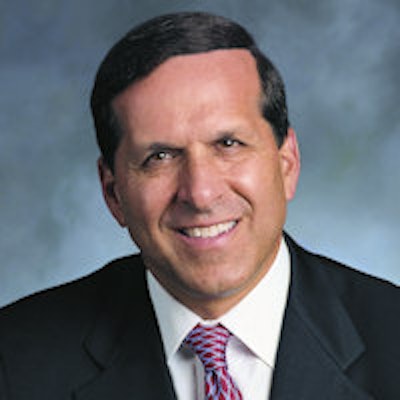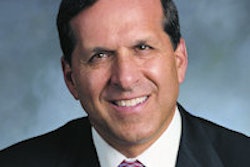
In his recently published book, Practice Turnaround: Succeeding in the New Dental Economy, Roger P. Levin, DDS, uses case studies to illustrate how his organization has helped struggling dental practices regain control and accelerate growth. The following is an excerpt from one of these success stories.
Most common career mistake
When the recession hit his area in 2008, Dr. Z's practice declined by 17%. This drop put him below the average production for general practices before the recession and significantly impacted his income. Dr. Z was never aware that by allowing his practice to run on autopilot, he was creating a scenario that left him open to significant danger.
 Roger P. Levin, DDS, chairman and CEO of practice management consulting firm Levin Group.
Roger P. Levin, DDS, chairman and CEO of practice management consulting firm Levin Group.When the practice began to decline, the doctor assumed it would be a short-term situation similar to past recessions, and he did not in any way alter his lifestyle. Rather than looking for ways to enhance practice growth, he simply began saving less money for retirement, which resulted in him putting away nothing at all.
He didn't recognize the long-term effect until 2011 when his practice had declined by about 7% and he was now in a position of having to borrow money to continue funding his lifestyle. When Dr. Z became a client of Levin Group, he was highly stressed, unhappy, and frustrated.
"I thought the recession would last only a year and that everything would then go back to normal," he said. "It never occurred to me that the recession would last this long or be this bad."
Insurance plans aren't always 'patient generators'
Dr. Z enrolled in several insurance plans, hoping for a surge in new patients. He didn't perform any analysis, including evaluating what percent of his revenue was derived from current insurance plans and which plans generated the most patients and production. Nor did he analyze how many patients participated in each plan and how many patients were in nonparticipating plans.
Unfortunately, like many practices have recently experienced, he did not acquire many new patients for one simple reason -- too many other practices were enrolling in the same plans, diluting the opportunity to attract new patients. To make matters even worse, he experienced a lower reimbursement on current patients who belonged to those plans. In essence, joining new insurance plans had backfired: He failed to gain new patients and received smaller fees for patients already in the practice. As a result, the practice continued to decline.
Waiting out the recession
When the doctor enrolled in our management and marketing programs, we performed a practice analysis. We identified that the practice was in middle decline, which occurs when a practice is experiencing declines of between 8% and 19%.
While it is positive that the doctor had decided to seek professional and expert guidance, he was three and half years late in making that decision. His chief mistake was that he had done little to improve his practice and simply waited for the economy to get better.
Cutting expenses will only get you so far
At the beginning of the recession, the doctor felt that the best strategy was to reduce expenses. While I endorse this strategy, it cannot be done while ignoring any potential for growth. Reducing expenses increased his profitability to a small degree, but it was overshadowed by the steep drops in production. Unfortunately, Dr. Z did not have the knowledge to implement strategies to grow his practice, which resulted in a multiyear decline.
 Practice Turnaround: Succeeding in the New Dental Economy by Dr. Roger P. Levin.
Practice Turnaround: Succeeding in the New Dental Economy by Dr. Roger P. Levin.As the practice began to decline, he released the two newest staff members, believing it was fairer to retain the senior team members. Unfortunately, the two laid-off employees were his best performers. Once again, Dr. Z used nonbusiness principles to make a decision.
Some of his senior team lacked the skills or motivation to move the practice forward during this challenging period. As an example, he retained front desk staff members who had no initiative to call overdue patients, attempt to keep 98% of patients scheduled, identify inactive patients, and so on. The doctor said that he "didn't mind" taking on excess responsibilities that the staff could not handle as the practice was slow and he had excess time on his hands.
The problem with this type of thinking is that his time could have obviously been better spent focusing on strategies and marketing activities to enhance practice growth. Instead, he ended up supporting staff members who weren't performing their duties properly and using free time for low-level activities.
When the doctor enrolled in our consulting programs, the first phase was to shore up the practice. We established 60-day goals, including the following:
- Scheduling 98% of all active patients
- Reactivating 85% of the overdue patients (those who hadn't been seen within 18 months)
- Contacting inactive patients (last seen three years ago or longer)
- Establishing an internal marketing program with 15 custom, ongoing strategies that motivate patients to refer family members and friends
- Training the doctor and the team to close 90% of all cases presented
- Establishing the "Four Financial Options" to ensure that most patients understand how they could afford treatment
The practice's efforts paid off. After 60 days, the office had increased production by 8%. By the end of six months, Dr. Z and his team had implemented many key management systems. The team received extensive training and was performing extremely effectively. The doctor also hired an internal marketing coordinator, a part-time team member who handles the practice's marketing efforts. Having a dedicated employee pays off huge dividends. For his practice, patient referrals increased by more than 25% and overall production spiked 18%.
Getting better
After nine months, Dr. Z's practice achieved 22% growth, with a target of another 19% in the second nine months. This type of growth would allow him to not only recover the losses sustained during the recession, but also realize positive net growth resulting in an even higher income than previously achieved.
While failure can happen to any dentist, it is important to note that if the doctor had acted sooner, he could have avoided much stress, frustration, and revenue loss. In my time as CEO, I have seen this scenario repeated often, albeit without recessions of this nature. There are many doctors who have spent years simply working day after day without planning or the realization that their practices could perform significantly better. Remember, if you fail to plan, you plan to fail. Perhaps one of the dangerous mistakes that dentists make is not maximizing opportunities early on and then having to play catch-up later in life.
Roger P. Levin, DDS, is the chairman and CEO of practice management consulting firm Levin Group.
The digital version of Practice Turnaround: Succeeding in the New Dental Economy is now available online for just $59.
The comments and observations expressed herein do not necessarily reflect the opinions of DrBicuspid.com, nor should they be construed as an endorsement or admonishment of any particular idea, vendor, or organization.
Copyright © 2015, Levin Group, Inc. Reprinted with permission.



















